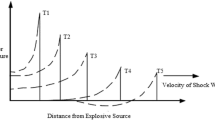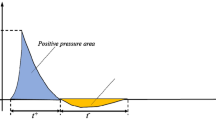Abstract
The blast loading from a detonation of a high explosive charge at high altitude is quite different from that at sea level. Due to diminished ambient pressure, the damage caused by the blast load may be more minor at high altitude. However, the shock wave parameters at diminished ambient pressure have not yet been thoroughly studied. In this research, experiments were carried out to study the relation between ambient air pressure and shock wave parameters. The explosion experiments were carried out in a sealed explosion chamber with an initial pressure of 95 kPa, 74 kPa, and 57 kPa. For these three atmospheric conditions, the history profiles of incident shock wave pressure generated by TNT charges of 106 g and 292 g were recorded. The influence of ambient pressure and temperature on the shock wave parameters was analyzed through numerical simulations. By analyzing the experimental and numerical data, it was found that ambient pressure is the main factor affecting the shock wave parameters, while the effect of temperature is not so obvious. Furthermore, based on the analysis of experimental data, formulas for evaluating shock wave overpressure, specific impulse, and arrival time using the Sachs variables are given, and the shock wave parameters at an altitude of 5000 m are calculated using these formulas. The observed maximum reduction in the shock wave overpressure was 23%, in specific impulse 27%, and in arrival time 12%, compared to the results calculated at sea level. The results can be applied to blast-resistant analyses of buildings in low-pressure environment.



















Similar content being viewed by others
Data availability
The data sets generated during and/or analyzed during the current study are available from the corresponding author on reasonable request.
References
Wang, E., Shukla, A.: Analytical and experimental evaluation of energies during shock wave loading. Int. J. Impact Eng. 37, 1188–1196 (2010). https://doi.org/10.1016/j.ijimpeng.2010.07.003
Ullah, A., Ahmad, F., Jang, H.W., Kim, S.W., Hong, J.W.: Review of analytical and empirical estimations for incident blast pressure. KSCE J. Civ. Eng. 21, 2211–2225 (2017). https://doi.org/10.1007/s12205-016-1386-4
Sachs, R.G.: The dependence of blast on ambient pressure and temperature. BRL Report No. 466 (1944)
Silnikov, M.V., Chernyshov, M.V., Mikhaylin, A.I.: Blast wave parameters at diminished ambient pressure. Acta Astronautica 109, 235–240 (2015). https://doi.org/10.1016/j.actaastro.2014.12.007
Silnikov, M.V., Mikhaylin, A.I.: Protection of flying vehicles against blast loads. Acta Astronautica 97, 30–37 (2014). https://doi.org/10.1016/j.actaastro.2013.12.012
Kinney, G.F., Graham, K.J.: Explosive Shocks in Air. Macmillan (1985)
Vivek, P., Sitharam, T.G.: Laboratory scale investigation of stress wave propagation and vibrational characteristics in sand when subjected to air-blast loading. Int. J. Impact Eng. 114, 169–181 (2018). https://doi.org/10.1016/j.ijimpeng.2018.01.003
Kudryavtsev, A.N., Borisov, S.P.: Stability of detonation waves propagating in plane and rectangular channels. Combust. Explos. Shock Waves 56, 92–99 (2020). https://doi.org/10.1134/S0010508220010116
Veldman, R.L., Nansteel, M.W., Chen, C.C.T., Toner, B.A.: The effect of ambient pressure on blast reflected impulse and overpressure. Exp. Tech. 41, 227–236 (2017). https://doi.org/10.1007/s40799-017-0171-8
Zeitoun, D.E., Burtschell, Y., Graur, I.A., Ivanov, M.S., Kudryavtsev, A.N., Bondar, Y.A.: Numerical simulation of shock wave propagation in microchannels using continuum and kinetic approaches. Shock Waves 19, 307–316 (2009). https://doi.org/10.1007/s00193-009-0202-1
Talay, T.A.: Introduction to the aerodynamics of flight. NASA SP-367, National Aeronautics and Space Administration, Washington, D.C. (1975)
Swisdak, M.M., Jr.: Explosion effects and properties, Part I. Technical Report NSWC/WOL/TR, 75-116 (1975)
Campidelli, M., Razaqpur, A.G., Foo, S.: Reliability-based load factors for blast design. Can. J. Civil Eng. 40, 461–474 (2013). https://doi.org/10.1139/cjce-2011-0411
Baker, W.E., Cox, P.A., Kulesz, J.J.: Explosion Hazards and Evaluation. Elsevier (2012)
Wei, T., Hargather, M.J.: A new blast wave scaling. Shock Waves 31, 231–238 (2021). https://doi.org/10.1007/s00193-021-01012-y
Borgnakke, C., Sonntag, R.E.: Fundamentals of Thermodynamics. Wiley (2021)
Bahadori, A., Vuthaluru, H.B.: Estimation of air specific heat ratio at elevated pressures using simple predictive tool. Energy Convers. Manag. 52, 1526–1532 (2011). https://doi.org/10.1016/j.enconman.2010.10.022
Alonso, F.D., Ferradas, E.G., Perez, J.F.S., Aznar, A.M., Gimeno, J.R., Alonso, J.M.: Characteristic overpressure-impulse-distance curves for the detonation of explosives, pyrotechnics or unstable substances. J. Loss Prev. Process Ind. 19, 724–728 (2006). https://doi.org/10.1016/j.jlp.2006.06.001
Wang, G.H., Lu, W.B., Yang, G.D., Yan, P., Chen, M., Zhao, X.H., Li, Q.: A state-of-the-art review on blast resistance and protection of high dams to blast loads. Int. J. Impact Eng. 139, 103529 (2020). https://doi.org/10.1016/j.ijimpeng.2020.103529
Cacoilo, A., Teixeira-Dias, F., Mourao, R., Belkassem, B., Vantomme, J., Lecompte, D.: Blast wave propagation in survival shelters: experimental analysis and numerical modelling. Shock Waves 28(1169–1183), 28 (2018). https://doi.org/10.1007/s00193-018-0858-5
Acknowledgements
This work was funded by the National Natural Science Foundation of China (No. 11402299).
Author information
Authors and Affiliations
Corresponding author
Additional information
Communicated by M. Hargather.
Publisher's Note
Springer Nature remains neutral with regard to jurisdictional claims in published maps and institutional affiliations.
Rights and permissions
Springer Nature or its licensor (e.g. a society or other partner) holds exclusive rights to this article under a publishing agreement with the author(s) or other rightsholder(s); author self-archiving of the accepted manuscript version of this article is solely governed by the terms of such publishing agreement and applicable law.
About this article
Cite this article
Chen, L., Li, Z., Chen, R. et al. Propagation characteristics of blast shock waves in low-pressure environment. Shock Waves 33, 61–74 (2023). https://doi.org/10.1007/s00193-022-01116-z
Received:
Accepted:
Published:
Issue Date:
DOI: https://doi.org/10.1007/s00193-022-01116-z




